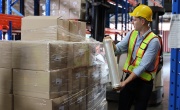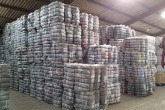Amendments to new EU Packaging Regulation could lead to a tsunami of plastics
The European Union (EU) is currently debating legislation which could lead to plastic flooding the market and turning back the dial on progress in reducing consumption of unnecessary plastic packaging. Andrew Large, Director General of the Confederation of Paper Industries, discusses.
 The Packaging & Packaging Waste Regulation (PPWR) will set new targets for the future of the European packaging industry. The paper-based Industries support the aspirations set out in the legislation, however, there are a series of amendments which could set a concerning precedent and risk an increase in the use of plastics, which is neither sustainable nor beneficial to the environment.
The Packaging & Packaging Waste Regulation (PPWR) will set new targets for the future of the European packaging industry. The paper-based Industries support the aspirations set out in the legislation, however, there are a series of amendments which could set a concerning precedent and risk an increase in the use of plastics, which is neither sustainable nor beneficial to the environment.
A recent peer-reviewed study commissioned by a European Trade Body (FEFCO) shows that recyclable packaging outperforms reusable packaging overall on a range of environmental indicators. The study also shows that reusable plastic crates would need to be reused 63 times to be better for the climate than corrugated alternatives.
Reusable packaging is not the ‘silver bullet’ that many people assume and can be worse for the environment than the recyclable alternative. Recyclable and reusable are complementary options, and both must be considered.
The amendments that have been proposed would introduce high levels of reusable packaging, without any evidence that it is beneficial. That will significantly increase the amount of plastic on the market with initial research suggesting this could lead to millions of tonnes more plastic packaging by 2030. This is contrary to the vast majority of public opinion, which wants less plastic waste in our parks, on our beaches, and in our oceans. Politicians too have a long-held ambition to decrease the amount of plastic in circulation and this is reflected in the EU’s political aspirations as outlined in the Green Deal and Circular Economy Action Plan.
Initial calculations suggest that the amendments could lead to 2.7 billion more plastic crates, weighing 4 million tonnes, on the market by 2030. The washing of just half of these reusable crates could consume 5 billion litres of water. By 2040 this could rise to 8.1 billion crates weighing 12 million tonnes, requiring 16 billion litres of water.
In recent days the paper-based industries have been shocked by these amendments which would impose mandatory reuse targets for transport packaging. We are calling on legislators to reject the amendments that would lead to significantly more plastic packaging and penalise paper-based products, which are the most recycled of all packaging materials.
Plastic does not break down easily, so when bottles, wrappers or crates reach the end of their life they remain in the environment. In contrast, cardboard is a sustainable choice for packaging as it is fully renewable, recyclable, and biodegradable. Recyclable paper-based packaging is frequently more compatible with 21st Century lifestyles, post-pandemic hygiene requirements, and existing recycling infrastructure. Indeed, around 80 per cent of UK-made paper utilises recovered (recycled) paper, this is by far the biggest use of recycled material from waste streams in the UK.
In addition to our superb credentials in terms of renewability and recycling, the paper industry has a clear ambition to decarbonise and has established a roadmap setting out a series of commitments.
This work responds to the EU Green Deal goal to cut greenhouse gas emissions by 80-95 per cent by 2050. The European corrugated cardboard industry is circular by nature and has always been committed to sustainable growth. This impressive new ambition reflects its continuous efforts to preserve the environment and reduce GHG emissions.
Building on past achievements and thorough analytical work, the roadmap describes how the corrugated cardboard sector is committed to achieving climate neutrality. It lays out key milestones, the most plausible scenarios, the required investments, and the necessary policy measures to reach this goal.
The Confederation of Paper Industries (CPI) want legislators to listen to the concerns being expressed by industry and not risk reversing the efforts of recent decades in tackling the blight of single-use plastics on our environment. If we are serious about transitioning to a circular economy, paper-based products must be at the heart of this, and we must consider the various factors which determine the sustainability of a material.








